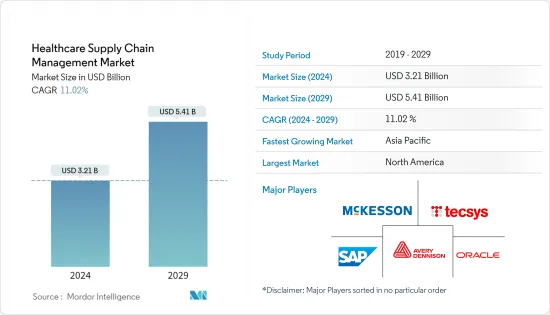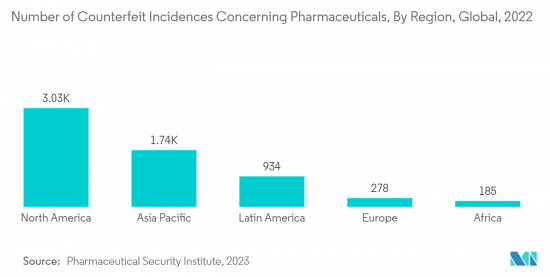
|
市場調査レポート
商品コード
1404440
ヘルスケアサプライチェーンマネジメント-市場シェア分析、業界動向・統計、2024年~2029年の成長予測Healthcare Supply Chain Management - Market Share Analysis, Industry Trends & Statistics, Growth Forecasts 2024 - 2029 |
||||||
カスタマイズ可能
適宜更新あり
|
|||||||
| ヘルスケアサプライチェーンマネジメント-市場シェア分析、業界動向・統計、2024年~2029年の成長予測 |
|
出版日: 2024年01月04日
発行: Mordor Intelligence
ページ情報: 英文 120 Pages
納期: 2~3営業日
|
全表示
- 概要
- 目次
ヘルスケアサプライチェーンマネジメント市場規模は2024年に32億1,000万米ドルと推定・予測され、2029年には54億1,000万米ドルに達し、予測期間(2024~2029年)のCAGRは11.02%で成長すると予測されます。

COVID-19は、パンデミックの初期段階で医薬品や手術器具の原薬が不足したと世界のいくつかの国が報告したため、ヘルスケアのサプライチェーンマネジメントに大きな影響を与えました。しかし、COVID-19のパンデミックは、医薬品のシームレスな追跡と追跡の必要性を生み出し、パンデミックの後期における市場の成長を押し上げました。
例えば、2022年3月にElsevier Public Health Emergency Collectionに掲載された記事によると、COVID-19パンデミックは前例のないスピードと規模で世界のサプライチェーンに影響を与えました。その記事によると、パンデミック後は需要と供給のギャップが拡大しました。現在、さまざまな企業が、医薬品を追跡するためのヘルスケア分野における革新的なサプライチェーンマネジメントソリューションを開発しており、そのため、調査された市場は予測期間中に成長すると予想されています。
市場成長を促進する主要要因は、コスト削減とサプライチェーンの品質向上に対するヘルスケアプロバイダーの取り組みの増加と、高品質な在庫管理システムに対する需要の高まりです。
様々なヘルスケアサプライチェーンマネジメントソフトウェアアプリケーションが提供する利点が需要の高まりにつながっており、これが市場成長を後押しすると予想されます。例えば、2022年11月にSaudi Pharmaceutical Journalに掲載された記事によると、より良い患者ケアを提供するために、在庫とサプライチェーンマネジメントは、主に生産性の向上、コストの削減、必要な物資を時間通りに受け取り、配布することに焦点を当てています。
在庫、購入、注文、支払いのワークフロー編成と追跡は、効果的なサプライチェーンマネジメントにかかっています。最近、ヘルスケア現場でのサプライチェーンマネジメントの利用が増加しています。ヘルスケア機関は、医薬品、ヘルスケア機器、消耗品などの在庫の計画、購入、管理、取り扱い、追跡、輸送を担っています。したがって、在庫管理は極めて重要であり、予測期間中にサプライチェーンマネジメント市場の成長を促進すると予想されます。
さらに、ヘルスケアサプライチェーンマネジメントソリューションを拡大するために、市場参入企業間の発売や提携が増加しており、予測期間中の市場成長を促進すると予想されます。例えば、2022年2月、Avery Dennison Smartracは、製薬用途向けのAD Minidose U9 RAIN RFIDインレイを発売し、ヘルスケア、薬局、検査室の資産管理に重要なRFIDの価値を解き放った。また、2021年8月には、フランスに本社を置くTageosが、ヘルスケアと製薬用途向けのEOS~202 U9 RAIN RFIDインレイを発売しました。
加えて、様々な政府機関によるサプライチェーンマネジメントソリューションの採用拡大がここ最近報告されており、これも予測期間中の市場成長に大きく寄与すると見られています。例えば、アラブ首長国連邦の保健省は2022年1月、医薬品関連情報にペーパーレスでアクセスできるQRコード付きAR搭載医薬品パックを発売しました。これは、患者が薬箱のQRコードをスキャンするだけで医薬品情報を読むのに役立ちます。
したがって、在庫管理ソリューションの利点、市場参入企業による発売の増加、政府組織によるサプライチェーンマネジメントの採用増加により、調査対象市場は分析期間中に成長を示すと予想されます。しかし、サプライチェーンマネジメントソフトウェアの導入コストが高いため、市場の成長は抑制されると予想されます。
ヘルスケアサプライチェーンマネジメント市場の動向
クラウドベースのセグメントが予測期間中に大きな成長を記録する見込み
クラウドベースのサプライチェーンソリューションが提供するネットワーク、ストレージ、容量は、柔軟性の高い利用ベースのモデルで運用されるため、迅速な更新や適応が可能です。規模拡大(または縮小)、新たな市場環境への適応、新たなパートナーとの接続、新たなサプライヤーの追加などは、すべて潜在的な用途です。
同分野は、調査研究の活発化とクラウドベースのソリューションの進歩により、予測期間中に成長すると予想されています。例えば、全米バイオテクノロジー情報センターが2022年8月に発表した記事によると、香港と米国で実施された研究では、クラウドベースのブロックチェーンの技術的な持続可能性は、効率的なヘルスケアサプライチェーンマネジメントのための人工知能(AI)と組み合わせることができると言及されています。したがって、このような研究は、クラウドベースのヘルスケアサプライチェーンマネジメント業務の開発を後押しします。
さらに、様々なヘルスケア組織によるクラウドベースのサプライチェーンソリューションの採用の高まりも、予測期間中のセグメント成長を押し上げると予想されています。例えば、2022年10月、インディアナ州を拠点とするMethodist Hospitalsは、クラウドソリューション企業のInforと提携し、財務、人事、サプライチェーン、オペレーションなど様々な分野の主要プロセスを標準化できるクラウドベースのヘルスケアアプリケーションを開発しました。このようなパートナーシップは、予測期間中にクラウドベースのソリューション市場を拡大すると予想されます。
さらに、先進的なクラウドベースのサプライチェーンマネジメントソフトウェアの発売は、市場の成長を促進すると予想されます。例えば、2022年5月、Jump Technologies社は、電子カルテ(EMR)、企業資源計画(ERP)、またはスケジューリングシステムと統合し、病院で使用される製品のロット番号とシリアル番号、と有効期限を記録するためのコンプライアンスを改善するモバイルスキャニングソリューションを強化するJumpStockと呼ばれるクラウドベースのソフトウェアソリューションを発売し、病院は、供給の買いだめ、医師の好みの相違、と在庫切れのコストを節約できるようになりました。
そのため、クラウドベースのサプライチェーンマネジメントの採用率が高く、市場参入企業による発売や提携が増加していることから、同分野は予測期間中に拡大すると予想されます。

北米が予測期間中に大きな市場シェアを占める見込み
北米は、大規模な製造拠点の存在と相まって、規格外医薬品や偽造医薬品によるリスクの増加、厳格な規制の枠組み、医薬品やヘルスケア機器へのGS1やユニークデバイスアイデンティフィケーション(UDI)の導入の義務化などにより、予測期間中、市場の主要シェアを占めると予測されます。例えば、2022年7月、食品医薬品局(FDA)は、米国で販売されるヘルスケア機器を製造から流通を経て患者の使用に至るまで適切に識別するための固有の機器識別システムに関する最終的なガイドラインと方針を発表しました。したがって、このような国政府のガイドラインや勧告が利用可能であることは、予測期間中、この地域におけるサプライチェーンマネジメントの需要を促進すると予想されます。
さらに、同地域での提携、パートナーシップ、製品発売など、市場参入企業によるさまざまな事業戦略の採用が増加していることも、市場拡大に寄与しています。例えば、2022年10月、ケベック州を拠点とするサプライチェーンマネジメントソフトウェア企業であるTecsys Inc.は、エンドツーエンドのEliteヘルスケアサプライチェーン実行プラットフォームの新機能「Elite Healthcare Receiving」を発表しました。この新機能は、ヘルスケアシステムのサプライチェーン業務に受入・配送プロセスをシームレスに統合する病院受入アプリケーションです。したがって、ヘルスケア機関におけるサプライチェーン業務を簡素化する新機能の追加は、予測期間中の市場成長を増強すると予測されます。
ヘルスケアサプライチェーンマネジメント業界概要
ヘルスケアサプライチェーンマネジメント市場は急成長している市場であり、その性質上競争は中程度です。現在の市場シェアは、ヘルスケア領域でサービスソリューションを提供する専門知識を持つ少数のヘルスケア技術企業によって主に支配されています。主要市場参入企業としては、SAP AG Group、Oracle Corporation、McKesson Corporation、Avery Dennison Corporation、Tecsys Inc.、Ochsner Health System、Providence Health &Servicesなどが挙げられます。
その他の特典:
- エクセル形式の市場予測(ME)シート
- 3ヶ月間のアナリスト・サポート
目次
第1章 イントロダクション
- 調査の前提条件と市場定義
- 調査範囲
第2章 調査手法
第3章 エグゼクティブサマリー
第4章 市場力学
- 市場概要
- 市場促進要因
- ヘルスケアプロバイダーによるコスト削減とサプライチェーンの品質向上への取り組みの増加
- 高品質の在庫管理システムに対する需要の高まり
- 市場抑制要因
- サプライチェーンマネジメントソフトウェアの導入コストの高さ
- ポーターのファイブフォース分析
- 新規参入業者の脅威
- 買い手/消費者の交渉力
- 供給企業の交渉力
- 代替品の脅威
- 競争企業間の敵対関係の強さ
第5章 市場セグメンテーション(金額ベース市場規模-100万米ドル)
- コンポーネント別
- ソフトウェアアプリケーション
- サプライヤー管理ソフトウェア
- 在庫管理ソフトウェア
- その他のソフトウェアアプリケーション
- ハードウェア
- バーコードスキャナー
- RFID
- その他のハードウェア
- ソフトウェアアプリケーション
- 配信モード別
- オンプレミス
- クラウドベース
- エンドユーザー別
- ヘルスケアプロバイダー
- ヘルスケアメーカー
- その他
- 地域
- 北米
- 米国
- カナダ
- メキシコ
- 欧州
- ドイツ
- 英国
- フランス
- イタリア
- スペイン
- その他の欧州
- アジア太平洋
- 中国
- 日本
- インド
- オーストラリア
- 韓国
- その他のアジア太平洋
- 中東・アフリカ
- GCC諸国
- 南アフリカ
- その他の中東・アフリカ
- 南米
- ブラジル
- アルゼンチン
- その他の南米
- 北米
第6章 競合情勢
- 企業プロファイル
- Advocate Healthcare
- Ascension Health
- Avery Dennison Corporation
- Tecsys Inc.
- Mckesson Corporation
- Oracle Corporatipon
- Providence Health & Services
- SAP AG Group
- Spectrum Health
- Ochsner Health System
- Aspen Technology Inc
- Infor
第7章 市場機会と今後の動向

The Healthcare Supply Chain Management Market size is estimated at USD 3.21 billion in 2024, and is expected to reach USD 5.41 billion by 2029, growing at a CAGR of 11.02% during the forecast period (2024-2029).
COVID-19 significantly impacted healthcare supply chain management as several countries worldwide reported that active pharmaceutical ingredients were in short supply of drugs and surgical equipment during the early phase of the pandemic. However, the COVID-19 pandemic created a need for the seamless tracking and tracing of pharmaceutical items, which boosted the market growth in the later phase of the pandemic.
For instance, according to an article published in Elsevier Public Health Emergency Collection in March 2022, the COVID-19 pandemic has impacted global supply chains at an unprecedented speed and scale. As per the article, gaps between supply and demand increased post-pandemic. Various companies are currently developing innovative supply chain management solutions in the healthcare segment for tracking pharmaceuticals, due to which the studied market is expected to grow during the forecast period.
The major factors driving the market growth are increasing efforts of healthcare providers to reduce cost and improve the quality of the supply chain and rising demand for the quality inventory management system.
The advantages offered by various healthcare supply chain management software applications are leading to their rising demand, which is expected to boost market growth. For instance, according to an article published in Saudi Pharmaceutical Journal in November 2022, in order to deliver better patient care, inventory and supply chain management primarily focuses on increasing productivity, reducing costs, and receiving and distributing the required supplies on time.
Workflow organization and tracking of inventory, purchases, orders, and payments depend on effective supply chain management. The use of supply chain management in healthcare settings has increased recently. Healthcare institutions are responsible for planning, purchasing, managing, handling, tracking, and transporting stock such as medications, medical equipment, and supplies. Therefore, inventory management is crucial and is expected to propel the supply chain management market growth during the forecast period.
Furthermore, the rising launches and partnerships among the market players to expand the healthcare supply chain management solutions are expected to propel the market growth during the forecast period. For instance, in February 2022, Avery Dennison Smartrac launched its AD Minidose U9 RAIN RFID inlay for pharmaceutical applications, unlocking critical RFID value for healthcare, pharmacies, and laboratory asset management. Also, in August 2021, Tageos, a French-headquartered company, launched its EOS-202 U9 RAIN RFID inlay for healthcare and pharmaceutical applications.
Additionally, the growing adoption of supply chain management solutions by various government bodies has been reported in recent times, which is also expected to significantly contribute to the market growth during the forecast period. For instance, in January 2022, the United Arab Emirates' Ministry of Health launched AR-powered drug packs with a QR code for paperless access to drug-related information. It will help patients to read drug information by simply scanning a QR code on the medicine box.
Therefore, owing to the advantages of inventory management solutions, rising launches by market players, and increasing adoption of supply chain management by government organizations, the studied market is anticipated to witness growth over the analysis period. However, the high cost of implementation of supply chain management software is expected to restrain market growth.
Healthcare Supply Chain Management Market Trends
Cloud based Segment is Expected to Register a Significant Growth Over the Forecast Period
The network, storage, and capacity provided by cloud-based supply chain solutions operate on a flexible, usage-based model that allows for faster updates and adaptations. Scaling up (or down), adapting to new market conditions, connecting with new partners, and adding new suppliers are all potential uses.
The segment is expected to grow during the forecast period owing to the rising research studies and advancements in cloud-based solutions. For instance, according to an article published in August 2022 by the National Center of Biotechnology Information, a study conducted in Hong Kong and the United States mentioned that the technical sustainability of cloud-based blockchain could be combined with artificial intelligence (AI) for efficient healthcare supply chain management. Therefore, such research studies boost the developments in cloud-based healthcare supply chain management operations.
Additionally, the rising adoption of cloud-based supply chain solutions by various healthcare organizations is also expected to boost segment growth during the forecast period. For instance, in October 2022, Indiana-based Methodist Hospitals partnered with cloud solutions company Infor to create a cloud-based healthcare application that will allow the health system to standardize key processes in various areas, such as finance, human resources, supply chain, and operations. Such partnerships are expected to expand the cloud-based solution market during the forecast period.
Furthermore, the launch of advanced cloud-based supply chain management software is expected to propel market growth. For instance, in May 2022, Jump Technologies launched a cloud-based software solution called JumpStock that integrates with the electronic medical record (EMR), enterprise resource planning (ERP), or scheduling systems and enhances its mobile scanning solution to improve compliance for recording lot and serial numbers, as well as expiration dates of product used in hospitals, allowing hospitals to save money on supply hoarding, physician preference variances, and stock-outs.
Therefore, owing to the high adoption of cloud-based supply chain management and rising launches and partnerships by market players, the segment is expected to propel during the forecast period.

North America is Expected to Hold a Significant Market Share Over The Forecast Period
North America is anticipated to hold the major share of the market over the forecast period owing to the increasing risks from substandard and falsified drugs and stringent regulatory frameworks, and mandatory implementation of GS1 and Unique Device Identification (UDI) on pharmaceutical drugs and medical devices, coupled with the presence of large manufacturing hubs. For instance, in July 2022, the Food and Drug Administration (FDA) published the final guidelines and policies regarding the unique device identification system to adequately identify medical devices sold in the United States from manufacturing through distribution to patient use. Therefore, the availability of such national government guidelines and recommendations is expected to propel the demand for supply chain management in the region during the forecast period.
Furthermore, the increasing adoption of various business strategies by the market players, such as collaborations, partnerships, and product launches in the region, is also contributing to the market expansion. For instance, in October 2022, Tecsys Inc., a Quebec-based supply chain management software company, launched a new feature, Elite Healthcare Receiving, in its end-to-end Elite Healthcare supply chain execution platform. The new feature is a hospital receiving application that seamlessly integrates receiving and delivery processes into a health system's supply chain operations. Therefore, the addition of new features to simplify the supply chain operations in healthcare organizations is projected to augment the market growth over the forecast period.
Healthcare Supply Chain Management Industry Overview
The healthcare supply chain management market is a fast-growing market and moderately competitive in nature. The current market share is majorly controlled by a few medical technology companies that have expertise in providing service solutions in the healthcare domain. Some of the key market players are SAP AG Group, Oracle Corporation, McKesson Corporation, Avery Dennison Corporation, Tecsys Inc., Ochsner Health System, and Providence Health & Services.
Additional Benefits:
- The market estimate (ME) sheet in Excel format
- 3 months of analyst support
TABLE OF CONTENTS
1 INTRODUCTION
- 1.1 Study Assumptions and Market Definition
- 1.2 Scope of the Study
2 RESEARCH METHODOLOGY
3 EXECUTIVE SUMMARY
4 MARKET DYNAMICS
- 4.1 Market Overview
- 4.2 Market Drivers
- 4.2.1 Increasing Efforts of Healthcare Providers to Reduce Cost and Improve the Quality of Supply Chain
- 4.2.2 Rising Demand of the Quality Inventory Management System
- 4.3 Market Restraints
- 4.3.1 High Cost of Implementation of Supply Chain Management Software
- 4.4 Porter's Five Forces Analysis
- 4.4.1 Threat of New Entrants
- 4.4.2 Bargaining Power of Buyers/Consumers
- 4.4.3 Bargaining Power of Suppliers
- 4.4.4 Threat of Substitute Products
- 4.4.5 Intensity of Competitive Rivalry
5 MARKET SEGMENTATION (Market Size by Value - USD million)
- 5.1 By Component
- 5.1.1 Software Application
- 5.1.1.1 Supplier Management Software
- 5.1.1.2 Inventory Management Software
- 5.1.1.3 Other Software Applications
- 5.1.2 Hardware Type
- 5.1.2.1 Barcode Scanners
- 5.1.2.2 RFID
- 5.1.2.3 Other Hardware Types
- 5.1.1 Software Application
- 5.2 By Delivery Mode
- 5.2.1 On-premise
- 5.2.2 Cloud based
- 5.3 By End User
- 5.3.1 Healthcare Providers
- 5.3.2 Healthcare Manufacturers
- 5.3.3 Others
- 5.4 Geography
- 5.4.1 North America
- 5.4.1.1 United States
- 5.4.1.2 Canada
- 5.4.1.3 Mexico
- 5.4.2 Europe
- 5.4.2.1 Germany
- 5.4.2.2 United Kingdom
- 5.4.2.3 France
- 5.4.2.4 Italy
- 5.4.2.5 Spain
- 5.4.2.6 Rest of Europe
- 5.4.3 Asia-Pacific
- 5.4.3.1 China
- 5.4.3.2 Japan
- 5.4.3.3 India
- 5.4.3.4 Australia
- 5.4.3.5 South Korea
- 5.4.3.6 Rest of Asia-Pacific
- 5.4.4 Middle East and Africa
- 5.4.4.1 GCC
- 5.4.4.2 South Africa
- 5.4.4.3 Rest of Middle East and Africa
- 5.4.5 South America
- 5.4.5.1 Brazil
- 5.4.5.2 Argentina
- 5.4.5.3 Rest of South America
- 5.4.1 North America
6 COMPETITIVE LANDSCAPE
- 6.1 Company Profiles
- 6.1.1 Advocate Healthcare
- 6.1.2 Ascension Health
- 6.1.3 Avery Dennison Corporation
- 6.1.4 Tecsys Inc.
- 6.1.5 Mckesson Corporation
- 6.1.6 Oracle Corporatipon
- 6.1.7 Providence Health & Services
- 6.1.8 SAP AG Group
- 6.1.9 Spectrum Health
- 6.1.10 Ochsner Health System
- 6.1.11 Aspen Technology Inc
- 6.1.12 Infor


